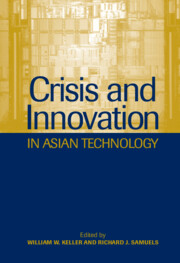Book contents
- Frontmatter
- Contents
- Figures and Tables
- Contributors
- Acknowledgments
- 1 Innovation and the Asian Economies
- 2 Japanese Production Networks in Asia: Extending the Status Quo
- 3 Crisis and Innovation in Japan: A New Future through Technoentrepreneurship?
- 4 Crisis, Reform, and National Innovation in South Korea
- 5 From National Champions to Global Partners: Crisis, Globalization, and the Korean Auto Industry
- 6 Crisis and Adaptation in Taiwan and South Korea: The Political Economy of Semiconductors
- 7 China in Search of a Workable Model: Technology Development in the New Millennium
- 8 Economic Crisis and Technological Trajectories: Hard Disk Drive Production in Southeast Asia
- 9 Continuity and Change in Asian Innovation
- Index
9 - Continuity and Change in Asian Innovation
Published online by Cambridge University Press: 15 December 2009
- Frontmatter
- Contents
- Figures and Tables
- Contributors
- Acknowledgments
- 1 Innovation and the Asian Economies
- 2 Japanese Production Networks in Asia: Extending the Status Quo
- 3 Crisis and Innovation in Japan: A New Future through Technoentrepreneurship?
- 4 Crisis, Reform, and National Innovation in South Korea
- 5 From National Champions to Global Partners: Crisis, Globalization, and the Korean Auto Industry
- 6 Crisis and Adaptation in Taiwan and South Korea: The Political Economy of Semiconductors
- 7 China in Search of a Workable Model: Technology Development in the New Millennium
- 8 Economic Crisis and Technological Trajectories: Hard Disk Drive Production in Southeast Asia
- 9 Continuity and Change in Asian Innovation
- Index
Summary
The Asian “Financial Crisis” Revisited
The Asian “financial crisis” of 1997–98 was in fact a number of crises, both economic and political. They did not begin in all affected states in Asia in 1997, nor did all end in 1998. It may be comforting to view the “financial crisis” as a limited and discrete phenomenon, during which investors temporarily abandoned a number of “bubble” economies until adjustments could be made and confidence restored, all in just eighteen months. But the evidence presented by the contributors to this volume clearly paints a different picture.
For some countries, the crisis began before 1997 and continued on past the turn of the millennium. In Japan, for example, the “crisis” only served to deepen a period of slow to no growth that prevailed throughout most of the 1990s, and worsened thereafter. For others, like Indonesia, the crisis was catastrophic. Financial disruptions of 1997 set events in motion that led to the collapse of a regime that had been in power for decades. With rampant political instability, direct investment flows to Indonesia turned negative in 1998 and continued to erode for the next several years. Taiwan, which at first appeared not to register the 1997–98 financial crisis, slipped in 2001 into its first recession in thirty years.
- Type
- Chapter
- Information
- Crisis and Innovation in Asian Technology , pp. 226 - 242Publisher: Cambridge University PressPrint publication year: 2003



